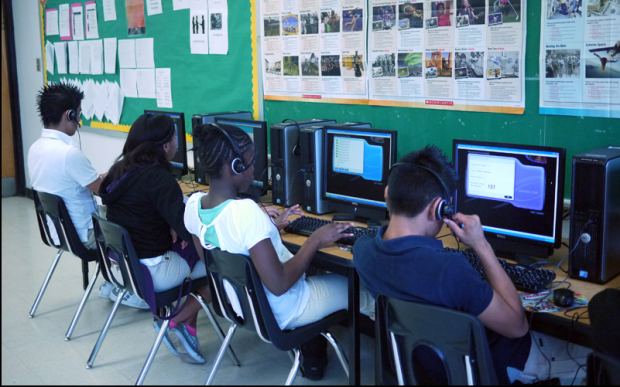Other companies are marketing similar software, too. And, increasingly, it’s not just for the weakest readers, but for all kids, in all subjects and in all grades. Schools are deciding how much time kids should spend in front of a computer in the classroom, without a whole lot of evidence about what works.
Accoo is so excited, he can tell you how many words he’s read each day. On this particular day, it was 341.
Going high-tech to teach reading
Asbury Park Middle School has three of these classrooms with a row of computers along a wall. The students work independently most of the time without a teacher’s help.
Linda Smolinski has been teaching for 32 years. This year her students are mainly Mexican immigrants and Haitian earthquake refugees. At first she was skeptical about using technology.
“I said ‘No. My kids can’t do that. There’s absolutely no way. My children don’t speak English. How do you expect them to sit at a computer and do something when I’m not even there helping them?’” Smolinski recalled.
She was eventually won over when Scholastic, the maker of the software, showed an increase in her students’ reading ability after just three months. The real test, however, will come later this year, when the state’s standardized tests will show whether or not the program is really working.
Superintendent Denise Lowe was hired away from Central Islip Long Island to help fix Asbury Park’s school system. The district has been a favorite target of Governor Chris Christie because it has one of the highest per pupil expenditures in the state, but its test scores are abysmal. Some 90 percent of the students at Asbury Park Middle School qualify for free and reduced price lunch. That measure of concentrated poverty qualifies them for extra school funding from the state.
Lowe said she’d had previous success with Scholastic’s Read 180 software in Long Island.
“This was pretty much the first thing I told my director to do that we need to look into Read 180,” Lowe explained. She spent $600,000, which she admits is a big investment.
The downside to technology
Some educators are critical of these fancy high-tech classrooms. Newark wanted to show off its computers, but technical problems caused them to cancel before a reporter’s visit. And there are other problems.
“They’re hearing distracted voices, these unnatural voices and not seeing human lips mouthing the words,” said Sandra Priest Rose, the chairman of the Reading Reform Foundation. Her organization trains teachers to teach reading in poor schools in New York City.
“It’s terribly important to have that human interaction and that spontaneous interaction that you cannot get on a computer,” Priest Rose said.
She added neuroscience research has found that the act of writing helps the brain learn better than tapping on a keyboard. Although, she will concede the software program can offer some useful data.
Smolinski said the program provides detailed information about the students’ skill gaps every day.
“On one of our first tests, most of them scored high 80s low 90s. Most teachers would say, ‘Fine, I’ll just move on.’ I noticed that every one of them bombed antonyms. That told me that I did not teach antonyms and I didn’t,” Smolinski said.
On the second test, her students again scored well. But the data report showed that they bombed capitalization.
And then there’s the Groupinator. It takes that skill gap analysis and places students in a group with kids who have similar needs.
“It tells me exactly what they need, when they need it. It does all my work for me,” Smolinski said.
Using both old and new techniques
In Asbury Park, part of the $600,000 investment included bright-green bean bag chairs and cushioned rockers, where, after their computer time, kids like Accoo can kick back with an old-fashioned book.
“I get to read my favorite books,” Accoo said. “Right now I’m reading Captain Underpants. The book I just got done reading recently was Frankenstein. And Frankenstein is mostly about this scientist and he creates life.”
Asbury Park’s teachers wish they could doctor more of these classrooms to serve all of their failing students. But right now there’s room for only 120 students a year.
This story was a collaboration between The Hechinger Report and New Jersey Public Radio.


